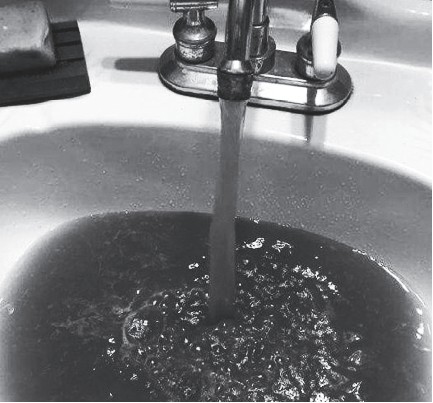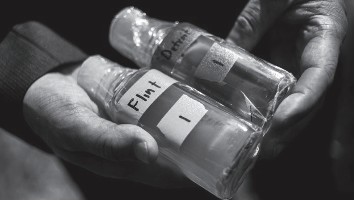November 29, 2016

What’s in Your Glass of Water?
Just how certain are you about the quality of the drinking water emerging from the faucet in your sink every day? Or the water in which you bathe, wash your clothes or steam your vegetables regularly? Do you really know what’s in the water you drink?
Probably these aren’t among the top 500 issues that hover near the apex of your stack of priority concerns — until a crisis breaks and it becomes glaringly apparent that these are questions we all should be asking. Like the residents of Flint, Michigan, whose drinking water was contaminated with lead and other chemicals when, as a cost-saving measure, their water supply was switched to the Flint River and certain treatment measures were eliminated. Or like the residents of Hoosick Falls, New York, who in 2015 discovered their town’s water supply was contaminated with Perfluorooctanoic acid (PFOA), a water and oil repellant used in the production of nonstick cookware, microwave popcorn bags and stain-resistant carpeting now being phased out.
New presences of Cr-6 in drinking water
And now, thanks to the release of an analysis of federal data compiled by the Environmental Working Group, a non-profit, non-partisan organization dedicated to protecting human health and the environment, it seems well over two-thirds of Americans — 218 million individuals — in all 50 states, may be living with unsafe levels of dangerous, cancer-causing hexavalent chromium in their drinking water.
Unfortunately, hexavalent chromium is also one of the very, very many chemicals utilized in industry that are either untested or under-tested for health impacts and safety. Industries benefit enormously from having this testing status remain in limbo. To learn more about this newly revealed threat to our water, go to http://www.ewg.org/research/chromium-six-found-in-us-tap-water.
All this begs the question: How do we really know what’s in the water we drink? If your water is sourced from a municipal water supply, you can contact your municipality or county water board to obtain details about how your water is treated, what it’s tested for and how often. Usually these are tests and treatments mandated by state and federal regulations. This information will also reveal any parameters for which tests aren’t being run. Please realize that the EPA recognizes only 88 regulated drinking water contaminants, and this list includes microorganisms, inorganic and organic chemicals, disinfectants disinfectants, disinfectant byproducts and radionuclides. Not all of these substances are acknowledged to cause the range of damage they’re capable of inflicting. Chromium, without being considered separately according to its three forms — chromium, trivalent chromium and hexavalent chromium — is noted as causing allergic dermatitis. Nor are all the sources of these substances recognized or identified.
What is your water tested for
If your water supply is a well, spring or other surface water source and a mortgage was involved, the property had to pass a water quality test indicating the presence of potable ater before you purchased your dwelling. That sounds reassuring, but what constitutes “potable?” When I purchased my home in 1988, the well passed with flying colors. When I moved in, all that emerged from the faucet was liquid black sludge. I called the Watershed Inspector to complain, and his response was: “Well, yes, it has the consistency of swamp water, but it’s free of fecal coliform bacteria, which is what we test for.” Wonderful! I had a huge overgrowth of iron bacteria. After digging up one massive boulder/well cover followed by a heavy chlorine shock treatment, I finally, I hope, had potable drinking water.
Ultimately, you’re never going to truly know EVERYTHING that’s in your water because for some substances chemical tests aren’t readily available or costs are too prohibitive or it’s not a substance raising any concern yet. However, the best way to learn about your water is to contact a certified lab and pay to have it tested. There are filters that can remove many harmful contaminants. Hexavalent chromium is removed by quality reverse-osmosis filters, as are many other chemicals. If you visit Environmental Working Group’s website, there’s a whole page devoted to water filtration system recommendations. The real issue is cost. Any suite of reliable and extensive water tests is going to be cost prohibitive — $500 or more — while home filtration units are equally expensive. Even faucet models can run into hundreds of dollars.
Consider that the 1.3% of freshwater on the planet that is surface water is the water used by humanity and every other species to maintain life. It’s becoming ever more polluted, approaching the point of being beyond recovery. Add to this the continued growth in human population and its insistence on embracing water-intensive diets and it’s impossible to ignore the looming water catastrophe on the horizon. According to the World Health Organization, by 2025 half the world’s population will be living in water-stressed areas. By 2050, that number will be two-thirds of the population.
Potable drinking water will be more valuable than gold if it can be protected and maintained. But to accomplish this, knowledge is key: knowing what’s in the water now and how to prevent further contamination in the future.
 Flint Michigan tap water after switching to Flint River as drinking water source. |
 Comparing tap water from Flint Michigan and Detroit Michigan. |
 Entering Hoosick Falls New York, site of recent PFOA drinking water contamination |